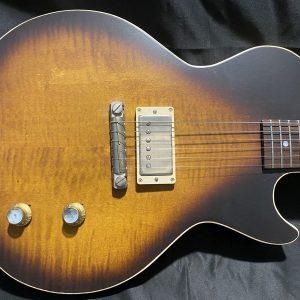
Gibson is one of the most established and recognizable brands in the history of guitar manufacture. Having been founded in 1894, they have provided musicians with a wide array of instruments, both acoustic and electric, with their most recognizable being Les Paul electric guitar, introduced in 1952. Gibson guitars have been used extensively throughout the years both in studios and on the road and are considered trusty workhorses for the players’ thanks to their sound, stability and classic image. Thus, these instruments are often seen having many wear and tear signs from the many hours of use. If these signs are only cosmetic, like the paint wearing down and flaking off or slight scratches and dents in the wood, and don’t interfere with the playability of the instrument, they are often referred to as mojo and may actually be desirable by some players or collectors, as they give a certain vintage and authentic aged look that is hard to get otherwise. On the other hand, there are also a lot of very old instruments that didn’t get played much – if at all - and remained in cases for decades, in which case their ‘mint’ condition warrants a much heftier price tag.
In both these scenarios though there is often some repair and restoration work to be done for these vintage instruments to be fully functioning again and reach their maximum sale prices.
Neck and Headstock Joint
As sturdy of a guitar as a Gibson is, it too has an Achilles’ heel and in this case, it is the back of the headstock. Unfortunately, it doesn’t take much effort for the back base of the headstock to either crack or break off completely - even a slight drop of the instrument on its back can cause serious damage. The good thing here is that with these accidents being so common, most guitar luthiers and repairmen will know how to handle even the most severe cases of injury. In cases of cracks in the back of the neck, the procedure usually involves cleaning off the debris, thoroughly sanding and applying special glues to hold the wood together before clamping it down and leaving it under pressure for days to settle again in place. In cases of completely separated headstocks, things can get trickier and depending on the situation there may be a need to replace the whole neck. Due to the nature of the construction of these instruments, the neck usually breaks right at the edge of the fretboard, where most experienced luthiers should have no problem re-attaching it, often using carbon fiber stripes as reinforcement and then using the same methods mentioned above to secure the neck and headstock together. After that, the neck may be repainted to cover up any visuals signs that remain of the damage and repair work.
Fret Leveling and Refretting
Fret unevenness is a very common issue that is encountered on most vintage instruments and understandably so. The more the guitars are played the more tension and friction is applied from the strings to the frets, causing wear and dents slowly over time in the fret material. Even if the instruments are not being played, several environmental factors can lead to unevenness in the frets’ height and placement on the neck. Thus, guitar repairmen are very often called to fret level a guitar neck, meaning making sure that all the frets are of the same height and composure, this way ensuring that there is no unwanted buzzing, fretting noise or intonation issues when the guitar is played. If the damage is irreparable, the situation may call for a full refretting of the neck, which means taking out all the old frets and replacing them with new ones – a risky and delicate procedure on one hand – with many merits though as it can fully restore an otherwise unplayable guitar back to a fully functioning instrument.
Conclusion
Post Your Ad Here

Comments